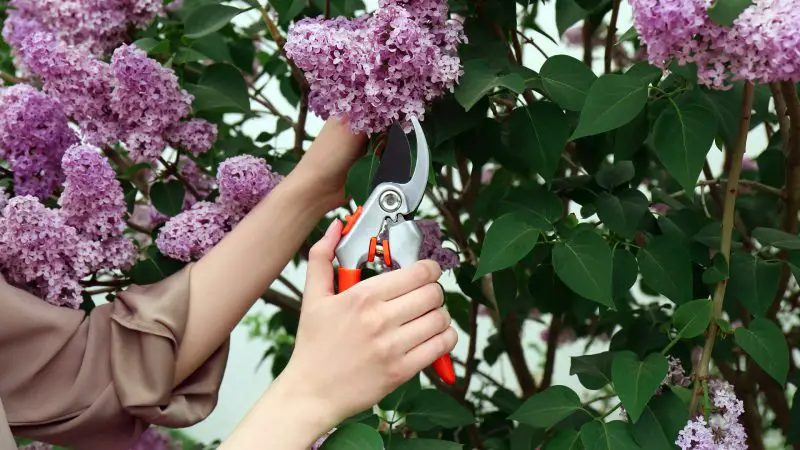Few sights in spring are as enchanting as a lilac bush in full bloom. With their sweet fragrance and clusters of soft purple, pink, or white flowers, lilacs turn any garden into a nostalgic and romantic haven. But behind their effortless charm lies a simple truth: to keep these beauties blooming year after year, proper pruning is essential.
Pruning a lilac bush may feel intimidating, especially when you’re worried about cutting off next year’s flower buds. The good news? With the right timing and gentle technique, you can shape your lilac for health and beauty without sacrificing a single bloom. In this guide, you’ll learn exactly how to prune your lilac bush to protect its flowering potential and encourage lush growth for seasons to come.
Understanding the Importance of Proper Lilac Pruning

Pruning is more than just a matter of shaping your lilac bush—it’s a critical step in ensuring the health, longevity, and flowering success of the plant. Lilacs bloom on old wood, which means they develop flower buds during the summer that won’t open until the following spring. If you prune too late or remove too much of the older growth, you may unintentionally cut off next year’s blooms.
Proper pruning helps open up the plant’s structure, allowing for better air circulation and light penetration, both of which reduce the risk of diseases such as powdery mildew. Over time, older lilac bushes can become woody and tangled, leading to fewer flowers and diminished vigor. By removing spent blooms and selectively thinning out older stems, you can rejuvenate your lilac bush and stimulate the growth of new flowering wood.
Done correctly, pruning not only preserves the beauty of next year’s flowers but also revitalizes the entire plant. Whether your lilac is newly established or decades old, consistent and mindful pruning helps maintain its natural elegance and ensures abundant blooms for years to come.
Knowing When Lilacs Bloom and Why It Matters
Lilacs typically bloom in mid to late spring, with most varieties reaching their peak in April or May, depending on your climate zone. Some newer hybrids offer extended bloom times or even repeat flowering later in the season, but traditional common lilacs (Syringa vulgaris) generally flower once a year on the previous season’s growth.
Understanding this bloom cycle is crucial because it directly affects how and when you should prune. Since lilacs set their flower buds shortly after blooming, pruning too late in the season—especially in summer or fall—will remove those buds before they’ve had a chance to open the following spring. This is one of the most common mistakes gardeners make, often resulting in a flowerless season.
By timing your pruning just after the blooms begin to fade, you give the plant enough time to recover, produce new shoots, and set buds for the next year. Recognizing the bloom period also helps you monitor your lilac’s health and evaluate whether it’s underperforming due to age, shade, or improper care. In short, knowing when lilacs bloom empowers you to make smart decisions that keep your garden vibrant and fragrant each spring.
Identifying Old Wood Versus New Growth
One of the most important steps in pruning lilacs correctly is learning to distinguish between old wood and new growth. Lilacs bloom on old wood—branches that grew during the previous season—so cutting these stems at the wrong time can eliminate next year’s flowers.
Old wood is typically thicker, darker, and more rigid. It often has a rougher texture, more pronounced bark, and may branch out into multiple older stems. These are the parts of the plant where flower buds developed last summer and are now ready to bloom in spring.
New growth, on the other hand, appears after the blooming season. These stems are more flexible, greener, and smoother in texture. They often emerge from the base of the plant or from the sides of older branches. While they don’t carry flower buds for the current season, they are essential for future blooming, especially the next year.
Understanding the difference helps you avoid removing the valuable old wood while still allowing room to thin out older, unproductive stems and make way for stronger, flower-bearing shoots. By preserving the right branches and encouraging balanced growth, you help your lilac bush remain productive, beautiful, and structurally sound for years to come.
Tools You Need for Safe and Effective Pruning
Using the right tools makes lilac pruning not only easier but also healthier for the plant. Sharp, clean tools ensure precise cuts that heal quickly and reduce the risk of disease. The most essential tool is a pair of bypass pruners, ideal for cutting stems up to half an inch thick without crushing them. For thicker, older branches, long-handled loppers give you extra leverage and clean cuts.
If your lilac bush is mature and has large, woody stems, a small pruning saw is useful for cutting through dense or awkwardly positioned branches. Always clean your tools with rubbing alcohol before and after use to prevent spreading fungal infections or pests.
Gloves are another must-have to protect your hands from splinters and scratches, especially when working in dense growth. With the proper tools in hand, pruning becomes a safer, more efficient process—and your lilac bush benefits from cleaner, healthier cuts.
Step-by-Step Process to Prune Without Removing Next Year’s Buds
Begin your pruning immediately after the lilac has finished flowering. Start by removing any spent flower clusters, cutting just above the first pair of healthy leaves. This prevents the plant from wasting energy on seed production and redirects growth to the stems.
Next, identify any dead, diseased, or damaged wood and remove it at the base. Then thin out overcrowded branches by cutting the oldest canes down to the ground. This opens up the bush, allowing light and air to reach the interior.
Always avoid pruning more than one-third of the bush at a time. Excessive pruning can shock the plant and reduce its ability to bloom. Gradual shaping over several seasons produces the best results and keeps the lilac in a continual cycle of renewal and bloom.
Rejuvenating an Overgrown Lilac Bush
When a lilac bush has been left unpruned for many years, it often becomes tall, woody, and flower production declines. Rejuvenating such a plant is entirely possible, but it requires patience and a strategic, multi-year approach. The goal is to gradually remove the oldest, thickest stems to encourage vigorous new growth from the base.
Start by identifying and cutting back one-third of the oldest canes in the early summer, right after the plant has finished blooming. This timing ensures that you don’t remove the buds for next year’s flowers. Over the next two years, continue removing another third of the old stems annually until all the older wood has been replaced by younger, more productive growth.
During the rejuvenation process, it’s important to avoid cutting all old stems at once, as this can shock the plant and halt blooming entirely for a season or two. Instead, slow, steady thinning helps the lilac redirect energy into producing strong, flowering canes. Within a few years, a neglected bush can return to its full blooming potential, rewarding you with healthy foliage and abundant springtime flowers.
Encouraging Flower Production After Pruning
Proper pruning is just the beginning—what you do afterward plays a vital role in whether your lilac bush bursts with blooms the following spring. Once you’ve removed old wood and shaped your plant, the focus should shift toward stimulating healthy, flower-producing growth.
First, ensure your lilac receives at least six hours of full sun each day. Light is one of the most critical factors in bud formation. If the bush is shaded by trees or buildings, consider relocating it or trimming surrounding vegetation to increase light exposure. Without enough sunlight, even perfectly pruned lilacs will fail to flower abundantly.
Next, avoid over-fertilizing. A high-nitrogen fertilizer will encourage leaf and stem growth at the expense of blooms. Instead, use a balanced or low-nitrogen fertilizer in early spring, or enrich the soil with compost to support steady, natural development. A soil test can also reveal whether your lilac lacks essential nutrients such as phosphorus, which is key to flower formation.
Water consistently, especially during dry spells, but don’t overwater. Lilacs prefer slightly dry conditions between waterings, and good drainage helps prevent root stress that can delay or reduce blooming.
Lastly, deadhead faded blooms immediately after flowering. This redirects the plant’s energy away from seed production and toward the development of next year’s flower buds, ensuring a fuller, more dramatic display with each passing season.
Seasonal Care for Pruned Lilacs
Caring for your lilac bush throughout the seasons after pruning is essential to maintain its health, promote consistent blooming, and prevent disease or stress. Each season brings unique needs that, when met, help your lilac thrive for years.
Spring
In early spring, inspect your pruned lilac for any winter damage. Remove dead or frost-damaged branches to make room for healthy new growth. This is also the ideal time to apply a light layer of compost or a balanced, slow-release fertilizer to support blooming. As flower buds begin to form, make sure the plant receives plenty of sunlight and moderate moisture to fuel its floral display.
Summer
Once the blooming period ends, deadhead spent flowers promptly to prevent the plant from wasting energy on seed production. This encourages more vigorous growth and prepares the bush to set buds for the next year. If you plan to do any shaping or light trimming, do it soon after flowering, as lilacs begin forming next season’s buds shortly thereafter. Continue watering during dry spells but avoid letting the soil stay soggy.
Autumn
In fall, begin tapering off watering to allow the lilac to harden off for winter. Avoid pruning during this season, as it may stimulate new growth that can be damaged by frost. Instead, focus on raking away fallen leaves and debris around the base of the shrub to prevent overwintering pests and fungal diseases. A thin layer of mulch can be applied after the first frost to insulate roots, but keep it a few inches away from the base to avoid rot.
Winter
During winter, lilacs require minimal care, but protection is key. In areas with harsh winters, ensure that heavy snow doesn’t weigh down or break branches. Gently brush snow off the bush after storms. If you’re in a zone with freeze-thaw cycles, a winter mulch layer helps stabilize soil temperature and moisture, reducing root stress.
By adjusting your care routine to each season’s demands, you give your lilac the best chance to recover from pruning, stay healthy, and bloom beautifully year after year.
Common Mistakes That Reduce Lilac Blooms
Pruning lilacs may seem straightforward, but a few common missteps can significantly reduce or eliminate blooms in the following season. Recognizing and avoiding these errors is key to keeping your lilac vibrant and full of flowers.
Pruning at the Wrong Time
The most frequent mistake is pruning too late in the season. Lilacs set their flower buds shortly after blooming, usually in early to mid-summer. If you prune in late summer, fall, or early spring, you risk removing these developing buds, resulting in no blooms the next year.
Over-Pruning or Cutting Back Too Severely
Lilacs respond well to light pruning and rejuvenation over time, but cutting back too much at once can shock the plant. Severe cuts can also remove too much old wood, which is where blooms typically form. Instead of heavy cutting, remove only a third of the oldest stems each year to gradually renew the shrub.
Neglecting to Remove Spent Blooms
While deadheading isn’t strictly necessary, leaving old blooms on the plant can divert energy into seed production rather than preparing new flower buds. Removing spent flowers shortly after blooming helps redirect energy toward healthy growth and next year’s blooms.
Ignoring Old, Woody Growth
Failing to remove older, non-productive stems can result in a crowded, airless shrub with limited blooming potential. Older stems typically flower less and can block sunlight from reaching younger, more vigorous shoots. Periodically removing these older canes improves airflow and encourages strong new growth.
Using Dull or Dirty Tools
Cutting lilacs with dull or unclean tools can damage stems and introduce disease. Ragged cuts take longer to heal and can leave the plant vulnerable to infection. Always use sharp, clean pruning shears or loppers to make precise cuts.
Avoiding these common mistakes will help ensure your lilac bush remains healthy, blooms reliably, and continues to enhance your garden with its signature fragrance and beauty.
Adapting Pruning Methods to Different Lilac Varieties
Not all lilacs are created equal—different varieties have unique growth habits, flowering times, and pruning needs. Understanding these differences allows you to tailor your pruning approach for better results.
Common Lilac (Syringa vulgaris)
This traditional lilac grows as a large shrub or small tree and blooms on old wood. It benefits from annual light pruning right after flowering. Remove spent blooms, thin out older stems, and shape the plant gradually to maintain airflow and promote blooming.
Dwarf Lilac Varieties
Dwarf types like ‘Miss Kim’ or ‘Bloomerang’ are compact and often require minimal pruning. For these, focus on removing dead or damaged wood and lightly shaping the plant for neatness. Deadheading helps prolong the bloom period, especially for reblooming types.
Tree Lilacs (Syringa reticulata)
Unlike shrub varieties, tree lilacs bloom later and require a different approach. Prune these only to remove dead branches or shape the canopy as needed, and do so in early spring or just after flowering. They don’t need annual pruning but benefit from occasional thinning.
Reblooming Lilacs
Varieties like ‘Bloomerang’ bloom multiple times a year and should be pruned more strategically. Light pruning after each bloom cycle encourages continued flowering. Avoid heavy cuts, which can interrupt the reblooming rhythm.
Adapting your pruning technique to each lilac type ensures healthier plants, maximized flowering, and a landscape filled with fragrance and color from spring into summer.
When to Skip Pruning Altogether
Although pruning plays a crucial role in maintaining a healthy lilac bush, there are specific times when it’s better to hold off. One of the most common situations is with newly planted lilacs. During their first year, these plants are focused on establishing a strong root system, so pruning can cause unnecessary stress and slow down their development.
Another reason to skip pruning is if your lilac did not bloom in the current season. Instead of rushing to cut it back, take time to evaluate the plant’s growing conditions, sunlight exposure, and soil health. Premature pruning—especially after a non-blooming season—can remove latent buds and further delay flowering.
Late-season pruning is also something to avoid. Cutting back lilacs in late summer or fall may remove the flower buds already forming for the next spring. This type of pruning also increases the risk of winter injury, as it stimulates new, tender growth that may not survive freezing temperatures.
In some cases, well-established and healthy lilacs don’t require annual pruning at all. If your bush is blooming beautifully, has good air circulation, and maintains an open structure, then heavy or even light pruning might be unnecessary. Knowing when to skip pruning altogether helps preserve future blooms and reduces the risk of unintentional damage.
Long-Term Benefits of Pruning Lilacs the Right Way
Pruning lilacs correctly isn’t just about shaping a pretty bush—it’s an investment in the plant’s long-term health and flowering potential. When done properly and at the right time, pruning helps your lilac maintain a balanced structure that supports strong growth and abundant blooms year after year.
Over time, unpruned lilacs tend to grow tall, leggy, and overcrowded in the center, which reduces air circulation and increases the risk of pests and diseases. Regular pruning eliminates older, less productive stems, making room for vigorous new shoots that produce the most fragrant and vibrant flowers. This process rejuvenates the plant and keeps it blooming at its best.
Correct pruning also prevents the lilac from becoming woody and overgrown. By managing its size and shape, you create a more attractive landscape feature that’s easier to maintain. With each season, a well-pruned lilac becomes more resilient to environmental stress, from drought to frost, and requires less corrective work in the future.
Ultimately, proper pruning extends the lifespan of your lilac, ensures reliable flowering, and helps the plant age gracefully while bringing beauty and scent to your garden for decades.
Frequently Asked Questions About Pruning Lilacs
When is the best time of year to prune a lilac bush to avoid cutting off next year’s blooms?
The best time to prune a lilac bush is immediately after it finishes blooming in late spring or early summer. This timing gives the plant enough time to grow new shoots that will develop flower buds for the next season. Pruning too late in summer, fall, or early spring will likely remove these buds and reduce blooming.
How do I know which branches to prune on an overgrown lilac?
On an overgrown lilac, focus on removing the oldest, thickest canes—usually gray and woody—that no longer produce many flowers. These can be cut back to the ground to make room for younger, more vigorous shoots. Also, remove any dead, damaged, or crossing branches to improve airflow and plant health. Always leave some younger stems intact, as they are the ones that will bloom next year.
Can I prune my lilac bush in the fall or winter?
No, pruning in the fall or winter is not recommended. During these seasons, lilacs are forming buds on the previous season’s wood. Pruning at this time will remove those buds and eliminate most, if not all, of the next spring’s flowers. Wait until the blooms fade in spring before doing any cutting.
How much of the lilac bush can I safely prune at one time?
You should never remove more than one-third of the lilac bush in a single season. Cutting back too much at once can shock the plant and slow its recovery. For severely overgrown lilacs, use a three-year rejuvenation method: remove one-third of the oldest wood each year to gradually renew the plant while preserving bloom potential.
Why is my lilac bush healthy but not blooming even after pruning?
If your lilac has plenty of healthy leaves but doesn’t bloom, several factors could be to blame. Pruning at the wrong time—especially in late summer or fall—can remove flower buds. Excessive nitrogen fertilizer may encourage leaf growth instead of flowers. Insufficient sunlight can also reduce blooms, as lilacs need at least six hours of direct sun per day. Lastly, age plays a role; very young plants or those recently rejuvenated may need a season or two to re-establish blooming habits.
Conclusion: Prune with Purpose for Lifelong Lilac Beauty
Pruning a lilac bush without damaging next year’s flowers is both an art and a science. With the right timing, proper tools, and an understanding of how your lilac grows, you can shape your plant into a thriving, bloom-covered centerpiece year after year.
Let your lilac bush reward your care with its unforgettable spring fragrance and showy blooms. When you prune with intention and knowledge, you ensure not just beauty for one season—but a garden legacy that grows fuller with every year.






